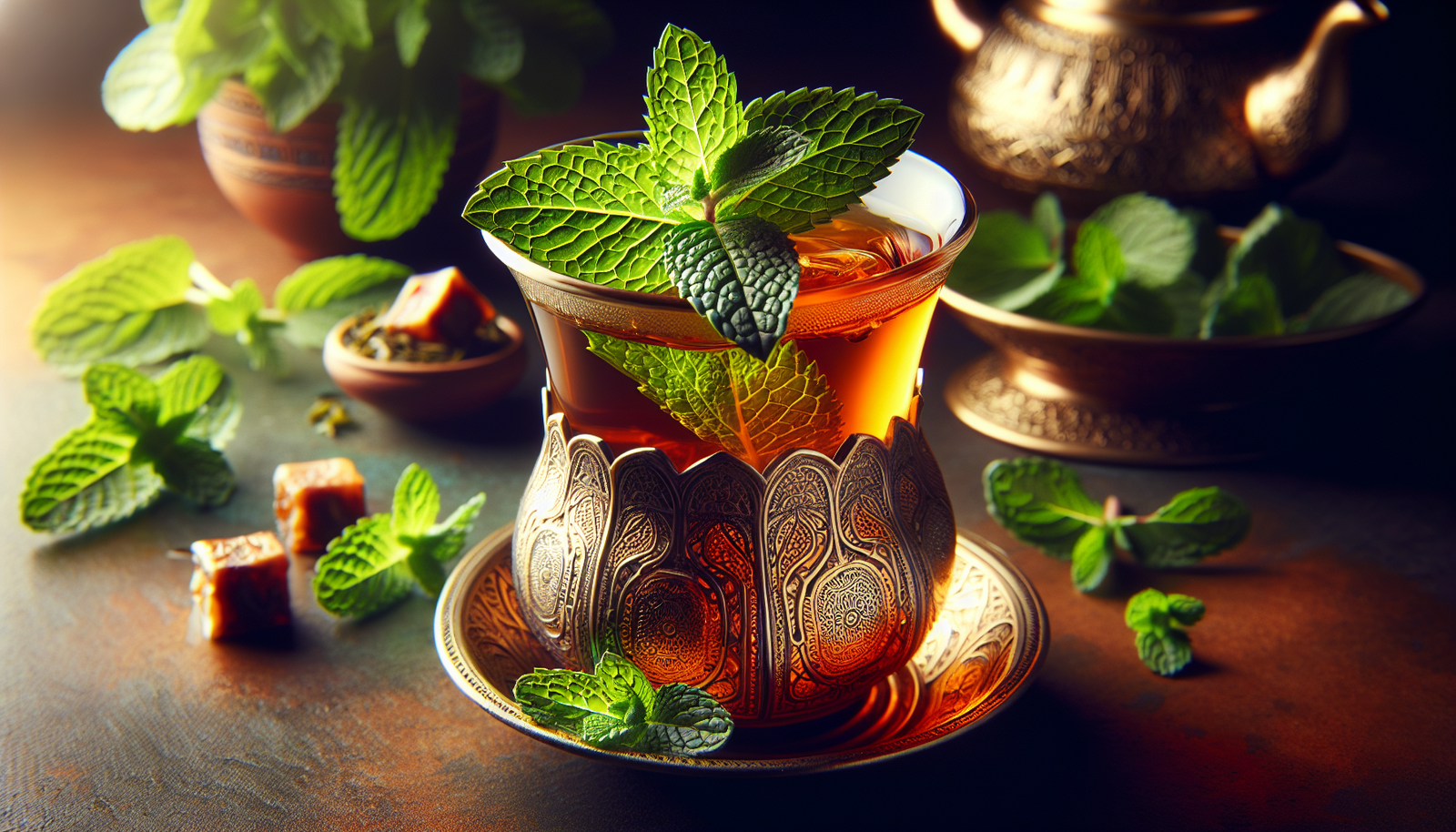Experience the richness of Moroccan gastronomy through the captivating flavors of Moroccan mint tea. This iconic beverage, steeped in tradition and hospitality, embodies the essence of Moroccan culture. With its refreshing combination of green tea, fresh mint leaves, and a touch of sugar, Moroccan mint tea is a delightful blend that awakens the senses and provides a moment of solace in the bustling streets of Morocco. From the intricate flavors to the vibrant presentations, this article delves into what makes Moroccan mint tea so special, highlighting its cultural significance and global appeal. So, grab a cup of tea, sit back, and embark on a journey to discover the secrets behind this beloved Moroccan beverage.
History of Moroccan Cuisine
Moroccan gastronomy is a celebration of the country’s rich history, diverse cultures, and unique geographical landscapes. Influenced by the Berber, Arab, Andalusian, and Mediterranean cultures that have shaped Morocco over centuries, Moroccan cuisine offers a captivating blend of flavors, spices, and presentations.
The traditional Moroccan tagine serves as a symbol of Moroccan cuisine. This slow-cooked stew is prepared in a specially designed clay cooking pot, also called a tagine. The tagine allows for the slow and even distribution of heat, resulting in tender and flavorful dishes. Tagines can be sweet, savory, or spicy, showcasing the complexity and depth of Moroccan cooking.
In addition to tagines, Moroccan cuisine features a variety of other dishes that display the culinary mastery of the region. Couscous, a staple grain, is often served with flavorful stews and a medley of vegetables. Pastilla, a savory pie with layers of flaky pastry filled with a combination of sweet and savory ingredients, represents the fusion of sweet and savory flavors that are characteristic of Moroccan cuisine. Moroccan pastries, with their delicate layers and rich fillings, are a testament to the country’s skilled pastry chefs. And no meal is complete without a fresh and warm loaf of Moroccan bread, often baked in traditional ovens called “fours.”
Moroccan Mint Tea as a Staple
Moroccan mint tea holds a special place in Moroccan households and is considered a staple beverage. This fragrant and refreshing tea is not only enjoyed daily but is also a symbol of Moroccan hospitality. Welcoming guests with a cup of mint tea is a tradition deeply rooted in Moroccan culture.
The preparation of Moroccan mint tea is an art form in itself. The tea leaves, usually green tea, are steeped with a generous amount of fresh mint leaves. The brewing process, done in a teapot called a “teyan,” requires time and patience. The tea is poured from a height into small glasses, creating a frothy layer on top called “bniya.” This pouring technique not only enhances the flavor but also cools the tea to a suitable drinking temperature.
Celebrating Moroccan Gastronomy
Morocco embraces its culinary heritage through various culinary events and festivals. These events showcase regional specialties and bring together chefs, food enthusiasts, and tourists to celebrate Moroccan gastronomy.
One such popular event is the “World Festival of Moroccan Gastronomy,” held annually in the city of Marrakech. This festival is a platform for Moroccan chefs to showcase their skills and creativity, preparing traditional dishes with a modern twist. The festival also features cooking demonstrations, food tastings, and cultural performances, offering visitors a true immersion into Moroccan cuisine and culture.
Other festivals, such as the “Festival of Dates” in Erfoud and the “Almond Blossom Festival” in Tafraoute, celebrate the rich bounty of Morocco’s agricultural produce. These events highlight the importance of fresh and local ingredients in Moroccan cooking, and attendees have the opportunity to sample a wide range of authentic dishes.
These culinary events not only promote Moroccan cuisine but also contribute to the local economy by attracting tourists from around the world and showcasing the country’s vibrant food scene.
Global Influence of Moroccan Cuisine
Moroccan cuisine has gained international recognition and can be enjoyed in Moroccan restaurants worldwide. With a growing number of establishments dedicated to Moroccan gastronomy, enthusiasts can experience the flavors and aromas of this rich culinary tradition.
Moroccan restaurants, often designed to reflect the vibrant Moroccan culture, offer a diverse menu that represents the different regions and influences within Morocco. From the bustling streets of Marrakech to the coastal towns of Essaouira, each region has its own signature dishes and flavors. These restaurants strive to adapt traditional Moroccan recipes to suit global palates, ensuring that the flavors remain authentic while appealing to a diverse range of tastes.
The popularity of Moroccan cuisine extends beyond dedicated restaurants. Moroccan flavors and cooking techniques have influenced international culinary trends. Chefs around the world are incorporating Moroccan spices, such as cumin, cinnamon, and turmeric, into their dishes, infusing them with the exotic and aromatic flavors of Morocco. Additionally, celebrities and food connoisseurs have embraced Moroccan cuisine, further popularizing it and making it a sought-after culinary experience globally.
Popularization of Moroccan Food
Moroccan cuisine has made a significant impact on international culinary trends, thanks to its enchanting flavors and unique blend of ingredients. Influential chefs and global food aficionados have praised Moroccan gastronomy for its depth and complexity, pushing it into the spotlight.
The popularity of Moroccan food can be attributed to several factors. Firstly, the inventive use of spices and herbs adds a distinctive flavor profile to Moroccan dishes. The combination of sweet and savory, spicy and aromatic, creates a harmonious balance that tantalizes the taste buds. Moreover, the focus on fresh and local ingredients ensures that Moroccan cuisine is at the forefront of the farm-to-table movement, appealing to those seeking high-quality and sustainable dining experiences.
Celebrities, including renowned chefs and Hollywood stars, have further fueled the popularity of Moroccan cuisine. Television shows and social media platforms highlight the beauty of Moroccan dishes and showcase the cultural significance behind each bite. As a result, Moroccan cuisine has become both fashionable and accessible, inviting individuals to explore its rich culinary tapestry.
Moroccan Gastronomy: More Than Just Food
Moroccan gastronomy is more than just a collection of delicious recipes; it is a reflection of a country’s culture and community. Each dish tells a story, weaving together the threads of Morocco’s history, traditions, and shared experiences.
This culinary tapestry blends ancient traditions with contemporary tastes, bridging the gap between the past and the present. From the bustling markets of Marrakech to the tranquil villages of the Atlas Mountains, the flavors and aromas of Moroccan cuisine permeate every corner of the country, connecting people and communities through the shared love of food.
Furthermore, Moroccan gastronomy acts as a catalyst for cultural exchange. As visitors indulge in Moroccan dishes, they are exposed to the customs, crafts, and hospitality that have shaped Morocco’s identity. Sharing a meal brings people from different backgrounds together, fostering understanding and appreciation for one another’s cultures.
Moroccan cuisine’s vibrancy and diversity are integral to the country’s cultural fabric, making it more than just food but a reflection of a nation’s soul.
Origins of Moroccan Mint Tea
Moroccan mint tea, a beloved beverage, has its roots in the introduction of tea to Morocco and the incorporation of mint into its preparation. Tea was introduced to Morocco by European traders in the 18th century, and it quickly became a popular drink in the country. However, it was the addition of fresh mint leaves that transformed ordinary tea into the iconic Moroccan mint tea we know today.
Traditional Tea Rituals
In Moroccan culture, tea preparation is not merely a task but an art form. The Moroccan tea ceremony is a revered custom that is passed down through generations, ingrained deeply in the social customs of the country. The preparation and serving of tea require precision and attention to detail, reflecting the values of hospitality, patience, and tradition.
The tea-making process begins with boiling water, typically in a teapot called a teyan. Once the water reaches a rolling boil, loose green tea leaves are added, along with a generous amount of fresh mint leaves. The mixture is allowed to steep, infusing the water with the delicate flavors of the tea and the aromatic essence of mint.
To create a frothy layer on top, the tea is poured from a height into small glasses, alternating between the teapot and the glass several times. This pouring technique, known as “high pouring,” cools the tea to a suitable drinking temperature and enhances the flavors. Moroccan hosts take pride in their pouring skills, creating a bniya, or frothy head, in the glass with each pour.
Flavor Profile of Moroccan Mint Tea
Moroccan mint tea is renowned for its refreshing and invigorating flavor profile. The blend of mild green tea and fresh mint leaves creates a harmonious balance of flavors, with each ingredient complementing the other.
The green tea used in Moroccan mint tea is typically a mild variety, allowing the flavors of the mint to shine through without overpowering the taste. The tea leaves provide a subtle bitterness that is counterbalanced by the natural sweetness of the mint.
The addition of fresh mint leaves infuses the tea with a burst of herbal freshness. The mint leaves release their essential oils during the steeping process, imparting a refreshing and invigorating aroma to the tea. This combination of flavors results in a beverage that is both soothing and uplifting, making Moroccan mint tea a popular choice throughout the day.
Health Benefits of Moroccan Mint Tea
In addition to its delightful taste, Moroccan mint tea offers a range of health benefits. The combination of green tea and fresh mint leaves provides a wealth of antioxidants, vitamins, and minerals that contribute to overall well-being.
Mint is known for its digestive properties and is often consumed after meals to aid digestion and soothe the stomach. Drinking Moroccan mint tea can help alleviate bloating, indigestion, and other digestive ailments, making it an ideal post-meal beverage.
Green tea, on the other hand, is rich in antioxidants called catechins. These antioxidants help protect the body against cell damage caused by harmful free radicals, reducing the risk of chronic diseases, such as heart disease and certain types of cancer.
Furthermore, Moroccan mint tea has calming and soothing properties. The natural aroma of mint has a relaxing effect, helping to alleviate stress and promote relaxation. This makes Moroccan mint tea a popular choice for those looking to unwind and find tranquility in their daily routines.
In conclusion, Moroccan cuisine is a vibrant tapestry of flavors and cultural influences. From traditional tagines to refreshing mint tea, Moroccan gastronomy offers a diverse range of dishes and beverages that celebrate the country’s history and traditions. Whether enjoyed in the bustling streets of Marrakech or savored in a Moroccan restaurant abroad, Moroccan cuisine is an invitation to immerse oneself in the richness of Moroccan culture. So next time you have the opportunity, treat yourself to a steaming cup of Moroccan mint tea, and embark on a sensory journey through the flavors and traditions of Morocco.

